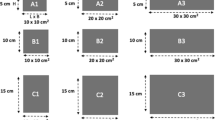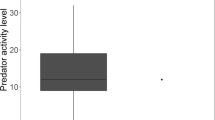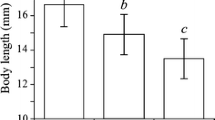Abstract
Reductions in aquatic habitat size facilitate encounters between predators and prey by reducing the height of the water column and the water volume. Here, we proposed to disentangle the effects of these mechanisms on predation rates and parameters of functional response curves of predators. We paired active-search predators (Buenoa, Hemiptera) or ambush predators (Pantala and Lestes, Odonata) with prey of different mobility types (Argyrodiaptomus, Copepoda; Culex, Diptera). Three treatments were established: high water column height and high water volume (H + V +), low water column height and high water volume (H − V +), and low water column height and low water volume (H − V−). We used contrast analysis to separate the effects of water column height (H + , H−) and water volume (V + , V−). Predation rates were higher in V− than in V + for Pantala and Buenoa consuming Argyrodiaptomus. In addition, we observed an increase in attack rates and a decrease in handling time in V− in relation to V + for Pantala and Lestes consuming Argyrodiaptomus. We concluded that reduction in the water volume was main responsible factor for the changes in predator–prey interactions. These changes depended on the prey behavior and predator foraging modes: ambush predators were the most benefited, and highly mobile prey were the most consumed.






Similar content being viewed by others
Data availability
The datasets generated during and/or analysed during the current study are available in the Zenodo repository, https://doi.org/10.5281/zenodo.5879944.
Code availability
Not applicable.
References
Amundrud, S. L., S. A. Clay-Smith, B. L. Flynn, K. E. Higgins, M. S. Reich, D. R. H. Wiens & D. S. Srivastava, 2019. Drought alters the trophic role of an opportunistic generalist in an aquatic ecosystem. Oecologia 189: 733–744.
Brooks, A. C., P. N. Gaskell & L. L. Maltby, 2009. Sublethal effects and predator-prey interactions: implications for ecological risk assessment. Environmental Toxicology and Chemistry 28: 2449–2457.
Buxton, M., R. N. Cuthbert, T. Dalu, C. Nyamukondiwa & R. J. Wasserman, 2020. Predator density modifies mosquito regulation in increasingly complex environments. Pest Management Science 76: 2079–2086.
Chandra, G., S. K. Mandal, A. K. Ghosh, D. Das, S. S. Banerjee & S. Chakraborty, 2008. Biocontrol of larval mosquitoes by Acilius sulcatus (Coleoptera: Dytiscidae). BMC Infectious Diseases 8: 138.
Coblentz, K. E. & J. P. DeLong, 2020. Predator-dependent functional responses alter the coexistence and indirect effects among prey that share a predator. Oikos 129: 1404–1414.
Crowley, P. H., 1979. Behavior of zygopteran nymphs in a simulated weed bed. Odonatologica 8: 91–101.
Cuthbert, R. N., D. Tatenda, R. J. Wasserman, A. Callaghan, O. L. F. Weyl & J. T. A. Dick, 2019. Using functional responses to quantify notonectid predatory impacts across increasingly complex environments. Acta Oecologica 95: 116–119.
Cuthbert, R. N., R. J. Wasserman, T. Dalu, H. Kaiser, O. L. F. Weylz, J. T. A. Dick, A. Sentis, M. W. McCoy & M. E. Alexander, 2020. Influence of intra- and interspecific variation in predator–prey body size ratios on trophic interaction strengths. Ecology and Evolution 10: 5946–5962.
Dalal, A., R. N. Cuthbert, J. T. Dick & S. Gupta, 2019. Water depth-dependent notonectid predatory impacts across larval mosquito ontogeny. Pest Management Science 75: 2610–2617.
Dalal, A., R. N. Cuthbert, J. T. Dick, A. Sentis, C. Laverty, D. Barrios-O’Neill, N. O. Perea, A. Callaghan & S. Gupta, 2020. Prey size and predator density modify impacts by natural enemies towards mosquitoes. Ecological Entomology 45: 423–433.
Daugaard, U., O. L. Petchey & F. Pennekamp, 2019. Warming can destabilize predator–prey interactions by shifting the functional response from Type III to Type II. Journal of Animal Ecology 88: 1575–1586.
De Clercq, P., J. Mohaghegh & L. Tirry, 2000. Effect of host plant on the functional response of the predator Podisus nigrispinus (Heteroptera: Pentatomide). Biological Control 18: 65–70.
Dewson, Z. S., A. B. James & R. G. Death, 2007. A review of the consequences of decreased flow for instream habitat and macroinvertebrates. Journal of the North American Benthological Society 26: 401–415.
Dick, J. T. A., M. E. Alexander, J. M. Jeschke, A. Ricciardi, H. J. MacIsaac, T. B. Robinson, S. Kumschick, O. L. F. Weyl, A. M. Dunn, M. J. Hatcher, R. A. Paterson, K. D. Farnsworth & D. M. Richardson, 2014. Advancing impact prediction and hypothesis testing in invasion ecology using a comparative functional response approach. Biological Invasions 16: 735–753.
Faria, L. D. B., W. A. C. Godoy & L. A. Trinca, 2004. Dynamics of handling time and functional response by larvae of Chrysomya albiceps (Dipt., Calliphoridae) on different prey species. Journal of Applied Entomology 128: 432–436.
Frances, D. N. & S. J. McCauley, 2018. Warming drives higher rates of prey consumption and increases rates of intraguild predation. Oecologia 187: 585–596.
Fulan, J. A. & M. R. dos Anjos, 2015. Predation by Erythemis nymphs (Odonata) on Chironomidae (Diptera) and Elmidae (Coleoptera) in different conditions of habitat complexity. Acta Limnologica Brasiliensia 27: 454–458.
Greene, C. H., 1986. Patterns of prey selection: Implications of predator foraging tactics. The American Naturalist 128: 824–839.
Hammill, E., O. L. Petchey & B. R. Anholt, 2010. Predator functional response changed by induced defenses in prey. The American Naturalist 176: 723–731.
Hammil, E., T. B. Atwood, P. Corvolan & D. S. Srivastava, 2015. Behavioural responses to predation may explain shifts in community structure. Freshwater Biology 60: 125–135.
Hassell, M. P., 1978. The dynamics of arthropod predator-prey systems, Princeton University Press, Princeton:
Holling, C. S., 1959. Some characteristics of simple types of predation and parasitism. The Canadian Entomologist 91: 385–398.
Holling, C. S., 1965. The functional response of predators to prey density and its role in mimicry and population regulation. Memoirs of the Entomological Society of Canada 97: 5–60.
Hothorn, T., F. Bretz & P. Westfall, 2008. Simultaneous inference in general parametric models. Biometrical Journal 50: 346–363.
Jeschke, J. M., M. Kopp & R. Tollrian, 2002. Predator functional responses: discriminating between handling and digesting prey. Ecological Monographs 72: 95–112.
Juliano, S. A. & M. E. Gravel, 2002. Predation and the evolution of prey behavior: an experiment with tree hole mosquitoes. Behavioral Ecology 13: 301–311.
Kiørboe, T., 2010. What makes pelagic copepods so successful? Journal of Plankton Research 33: 677–685.
Klecka, J. & D. S. Boukal, 2013. Foraging and vulnerability traits modify predator–prey body mass allometry: freshwater macroinvertebrates as a case study. Journal of Animal Ecology 82: 1031–1041.
Klecka, J. & D. S. Boukal, 2014. The effect of habitat structure on prey mortality depends on predator and prey microhabitat use. Oecologia 176: 183–191.
Kolar, V., D. S. Boukal & A. Sentis, 2019. Predation risk and habitat complexity modify intermediate predator feeding rates and energetic efficiencies in a tri-trophic system. Freshwater Biology 64: 1480–1491.
Laverty, C., J. T. A. Dick, M. E. Alexander & F. E. Lucy, 2015. Differential ecological impacts of invader and native predatory freshwater amphipods under environmental change are revealed by comparative functional responses. Biological Invasions 17: 1761–1770.
Ledger, M. E., L. E. Brown, F. K. Edwards, A. M. Milner & G. Woodward, 2013. Drought impacts on the structure and functioning of complex food webs. Nature Climate Change 3: 223–227.
Li, Y., B. C. Rall & G. Kalinkat, 2018. Experimental duration and predator satiation levels systematically affect functional response parameters. Oikos 127: 590–598.
McHugh, P. A., R. M. Thompson, H. S. Greig, H. J. Warburton & A. R. McIntosh, 2015. Habitat size influences food web structure in drying streams. Ecography 38: 700–712.
McMeans, B. C., K. S. McCann & M. Humphries, 2015. Food web structure in temporally-forced ecosystems. Trends in Ecology & Evolution 30: 662–672.
Mondal, R. P., G. Chandra, S. Bandyopadhyay & A. Ghosh, 2017. Effect of temperature and search area on the functional response of Anisops sardea (Hemiptera: Notonectidae) against Anopheles stephensi in laboratory bioassay. Acta Tropica 166: 262–267.
Murdoch, W. W., 1969. Switching in general predators: experiments on predator specificity and stability of prey populations. Ecological Monographs 39: 335–354.
Paterson, R. A., J. T. A. Dick, D. W. Pritchard, M. Ennis, M. J. Hatcher & A. M. Dunn, 2015. Predicting invasive species impacts: a community module functional response approach reveals context dependencies. Journal of Animal Ecology 84: 453–463.
Previatelli, D. & E. N. Santos-Silva, 2007. A new Argyrodiaptomus (Copepoda: Calanoida: Diaptomidae) from the southwestern Brazilian Amazon. Zootaxa 1518: 1–29.
Pritchard, G., 1965. Prey Capture by Dragonfly Larvae (Odonata, Anisoptera). Canadian Journal of Zoology 43: 271–289.
Pritchard, D. W., R. A. Paterson, H. C. Bovy & D. Barrios-O’Neill, 2017. FRAIR: An R package for fitting and comparing consumer functional responses. Methods in Ecology and Evolution 8: 1528–1534.
R Core Team, 2019. R: A language and environment for statistical computing. R Foundation for Statistical Computing, Vienna, Austria. URL https://www.R-project.org/.
Roland, F., V. L. M. Huszar, V. F. Farjalla, A. Enrich-Prast, A. Amado & J. P. H. B. Ometto, 2012. Climate change in Brazil: perspective on the biogeochemistry of inland waters. Brazilian Journal of Biology 72: 709–722.
Rosset, V., A. Ruhi, M. T. Bogan & T. Datry, 2017. Do lentic and lotic communities respond similarly to drying? Ecosphere 8: 01809.
Saha, N., G. Aditya, S. Banerjee & G. K. Saha, 2012. Predation potential of odonates on mosquito larvae: implications for biological control. Biological Control 63: 1–8.
Sarnelle, O. & A. E. Wilson, 2008. Type III functional response in Daphnia. Ecology 89: 1723–1732.
Shaalan, E. A. & D. V. Canyon, 2009. Aquatic insect predators and mosquito control. Tropical Biomedicine 26: 223–261.
Sodré, E. d. O. & R. L. Bozelli, 2019. How planktonic microcrustaceans respond to environment and affect ecosystem: a functional trait perspective. International Aquatic Research 11: 207–223.
Sundell, J., J. A. Eccard, R. Tiilikainen & H. Ylönen, 2003. Predation rate, prey preference and predator switching: experiments on voles and weasels. Oikos 101: 615–623.
van Uitregt, V. O., T. P. Hurst & R. S. Wilson, 2013. Greater costs of inducible behavioural defences at cooler temperatures in larvae of the mosquito, Aedes notoscriptus. Evolutionary Ecology 27: 13–26.
Varshini, R. A. & M. Kanagappan, 2014. Effect of quantity of water on the feeding efficiency of dragonfly Nymph Bradynopyga geminata (Rambur). Journal of Entomology and Zoology Studies 2: 249–252.
Acknowledgements
RMGC and JLSF are grateful to Vale S.A. and the Coordination of Superior Level Staff Improvement (CAPES) for Master and PhD scholarships, respectively. VFF is partially supported by a CNPq productivity grant (Process 310119/2018-9).
Funding
This research was funded by Vale SA.
Author information
Authors and Affiliations
Contributions
All authors conceived the ideas and designed the methodology; RMGC and JLSF collected and analyzed the data; RMGC led the writing of the manuscript. All authors contributed critically to the drafts and gave final approval for publication.
Corresponding author
Ethics declarations
Conflict of interest
Authors declare no conflict of interest in this research.
Additional information
Handling editor: Marcelo S. Moretti.
Publisher's Note
Springer Nature remains neutral with regard to jurisdictional claims in published maps and institutional affiliations.
Supplementary Information
Below is the link to the electronic supplementary material.
Rights and permissions
About this article
Cite this article
Costa, R.M.G., Ferro, J.L.S. & Farjalla, V.F. Disentangling the mechanisms related to the reduction of aquatic habitat size on predator–prey interactions. Hydrobiologia 849, 1207–1219 (2022). https://doi.org/10.1007/s10750-021-04781-w
Received:
Revised:
Accepted:
Published:
Issue Date:
DOI: https://doi.org/10.1007/s10750-021-04781-w




